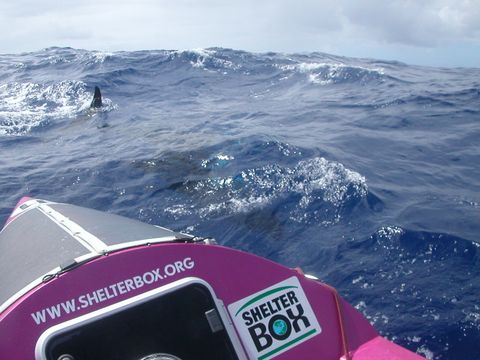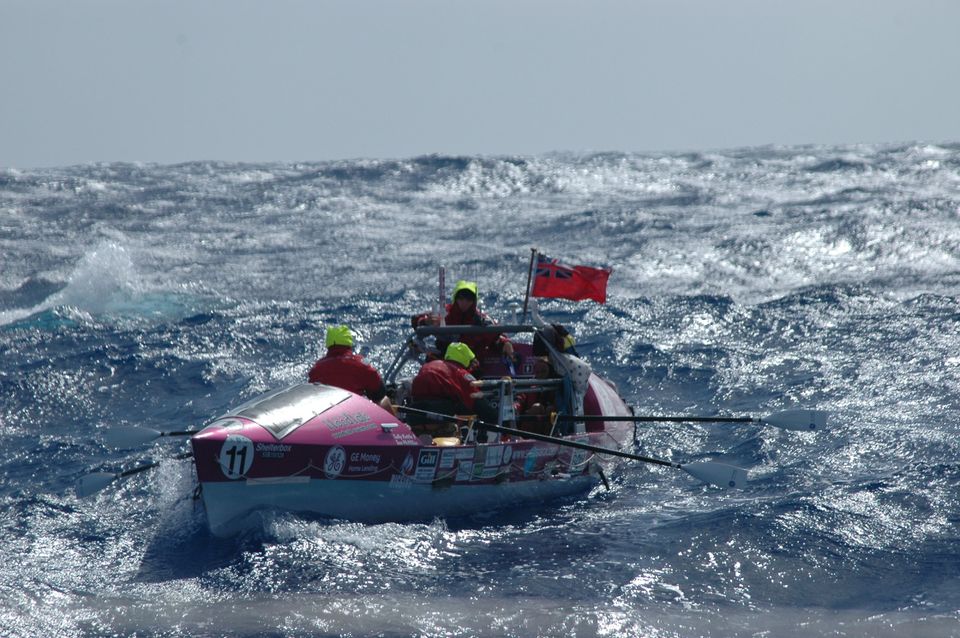The Atlantic Rowing Race
Sally Kettle is a name synonymous with adventure and Ocean Rowing. Sally has rowed the Atlantic twice picking up a Guinness World Record and raising a staggering amount of money for charity as a result. Here Sally gives some insight into what it takes to row an ocean with some great training and fundraising advice as well.
Who are you
Sally Kettle
The Challenge
Atlantic Rowing Race 2003/4 and 2005/6
How long did it take
1st Time – 105 days , 2nd Time – 77 days
What was the distance
Just over 3000 miles (a few extra with some figure of 8’s)
How much did it cost
£50 -£75k
Who was / is the organiser
Woodvale, but now its run by Atlantic Campaigns

What was it like
Both ocean rows were incredible, and changed my life. They were also the most difficult things I’ve ever done. The rowing schedule is hardcore – 1 ½ hrs on / 1 ½ hrs off during the day, 3hrs on/ 3hrs off during the night – so is the seasickness, lack of sleep and mind numbing boredom of days at sea. But I always describe it as “camping at sea, instead of hill and cows, it’s waves and whales.
”
Nothing prepares you for the struggle that is raising sponsorship for the trip. Not only is it very stressful, but also there’s a constant pressure to self-fund over and above your financial abilities.
My first trip created circumstances that left me ‘signing on’, and there’s been more than a few teams who have returned from the adventure with enormous debts.
I learnt a lot in the preparation, the most important being “the more time you give to the project the more likely you are to get sponsorship. If you can’t give time, then be prepared to self-finance”.
Finding your sponsors and creating and maintaining a professional relationship with them takes time.
When hardened ocean rowers tell you, “If you can make it to the start, then you can make to the finish” this is definitely true. On both occasions we spent over a year getting the row together, but whenever I felt like crap at sea I reminded myself what it took to get there.

As for the row, well I’ve never spent so much time in pain! From blisters to sciatica, constant muscle pain to overwhelming exhaustion I was in pain 24hrs a day. If you intend to take this on, know that it will be emotionally and physically painful.
Having said that, we made it across and arrived with smiles on our faces!
With the Rowgirls crew in particular we faced horrendous conditions, huge seas, ferocious winds and rain for a month! We also struggled with injuries, which led to one of the team leaving the boat and disqualifying us from the race.
It was an emotional rollercoaster but we pulled together and against the odds (no rudder, a shark attack and a broken watermaker) we still crossed the finish line.
It’s very easy to get caught up in the race, and many a crew have come home lamenting the fact that they didn’t make the crossing fast enough, that they didn’t win the race, or beat such and such a team or that so and so cheated.
For many it will be their only opportunity to sit in a little wooden rowing boat in the middle of an ocean, away from the stresses and strains of modern life, travelling at the speed of a passing whale. If I’ve learnt anything from my adventures it’s this – take time to appreciate it, because what seems to be never ending will be over in the blink of an eye. So when you head out there stop rowing, watch for whales and swim in water 7 miles deep!

How should you / did you train
My thoughts have changed a lot when it comes to training since completing my ocean rows. I now believe there are two ways to look at it. 1. What physical training will make you feel capable of completing the row, and 2. What training will actually make you capable of completing the row and returning to land in good shape?
As a novice I remember focusing on no.1. – pounding out hours of rowing on an erg, believing it would fully prepare me for the trip. It didn’t. But when I got to the start line I mentally felt able to complete the task. I returned having lost a considerable amount of skeletal muscle, which converted itself into fat as I regained my lost 2 stones, and I caught every cold going.
I also wasn’t very strong whilst out at sea, this probably resulted in the constant pain.
If I could change the way I trained for the adventure, I would focus on gaining muscle, especially in my core, my back and legs and spending less time on the rowing machine. I think this is particularly important for female teams as we women carry a lot less muscle, so we need to gain more and be ready to lose it, along with body fat, whilst at sea.
Instead I would spend more time on weight and flexibility training and stick to rowing on board the boat. This can be tricky if you’re still raising money to buy it, but when you look at those who have had successful and fast crossing they spent a good proportion of their training getting comfortable at sea in a boat.
Having qualified as a Personal Trainer I’m now more than happy to support any team who plan to attempt a crossing.
So please do contact me if you’d like a specific training plan – 07786 805461 or www.dont-hope-do.com
Any other useful hints / links
Really think about the Time/Money equation. If you can’t spend time finding money to fund your adventure then expect to fork out using your own finances. I personally do not believe the row is worth remortgaging your home or leaving yourself in debt because you’ve over borrowed.
There are sponsors out there and they are usually somebody you already know, you just have to spend a lot of time trying to find them.
Also, you don’t always have to find cash, take a look at your long list kit etc. much of it can be sponsorship in kind. You only need ready cash for purchasing the boat, race entry fees, insurance, shipping, travel and accommodation.
Look at the row as a physical job, much like a builder or a gardener. Your job is to row. It doesn’t seem so hard if you imagine you’re committing to a job rather than an ‘endurance challenge’.
Know that you will make mistakes, and it doesn’t matter how many rowers you talk to before you go. They’ll be more than happy to tell you what they should or shouldn’t have done. Take their advice but know that you’ll do something daft anyway!
Be careful with charities. Remember, with no disrespect to them, it’s in their nature to be selfish. It’s very easy to over commit time and energy to a charity and struggle to fund and train for the row. Be sure that any relationship you plan to have with your charity is very clear i.e. will you only give them money after you’ve made it to the start line? How will you proportion donations? For example, you desperately need a life jacket but a donor has given you £100 for the charity- who will you spend the money on? How much support will the charity give you? Will they approach their regular fundraisers and ask them to raise on your behalf or will they just give you some balloons and a bucket and let you get on with it?
If you want to raise a significant sum, and my rows raised almost £300,000, then your charity has to be part of team. You can’t organise this on your own, and a charity already has the resources and the infrastructure to do it. Buy them into the challenge and ask them to work as hard for you as you will for them and I promise the rewards will be sweeter!
Finally, leave your arrogance at home. I’ve been to many race starts and can tell you that every single team who has strutted about the pontoons with a chip on their shoulder has returned to eat humble pie. The ocean doesn’t care about the race, and it will break you if it sees fit, and once you’re out there your most important priority is to return to your loved ones alive.
To find out more about ocean rowing go to:
View More Articles
Services List
-
Land This is a text area. Writing in paragraphs lets your visitor find what they are looking for quickly and easily. Edit the text in the list editor.
Land -
Water Expeditions This is a text area. Writing in paragraphs lets your visitor find what they are looking for quickly and easily. Edit the text in the list editor.
Water Expeditions -
Ice Expeditions This is a text area. Writing in paragraphs lets your visitor find what they are looking for quickly and easily. Edit the text in the list editor.
Ice Expeditions
